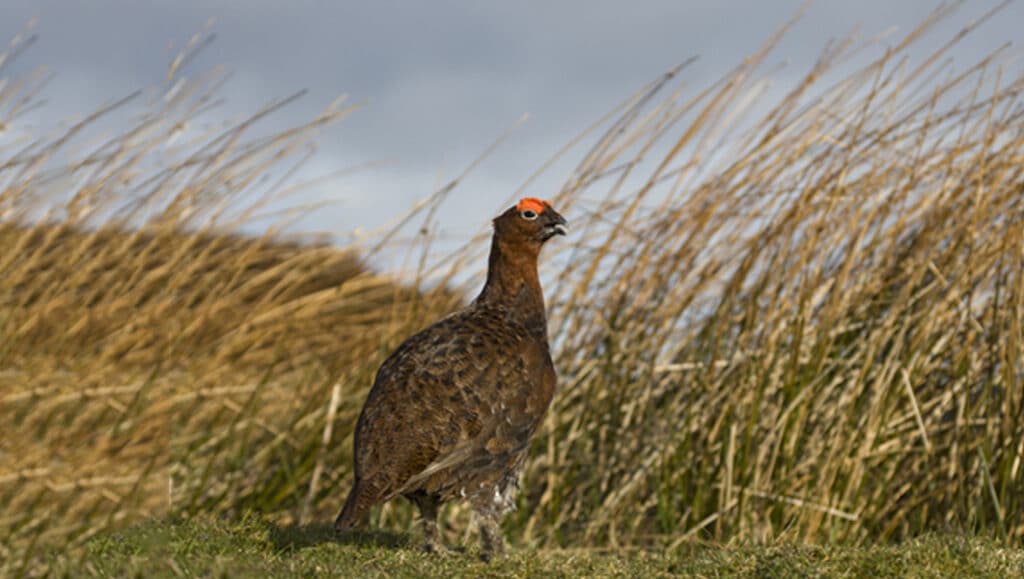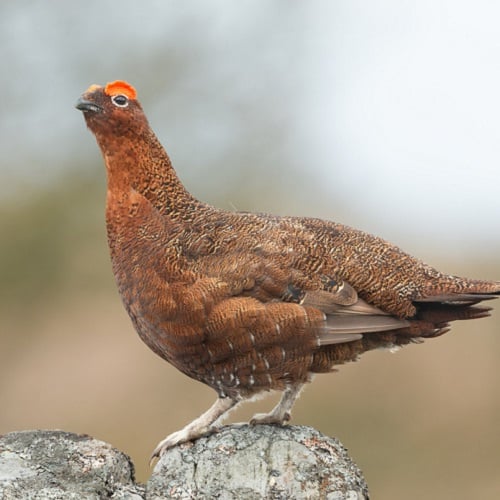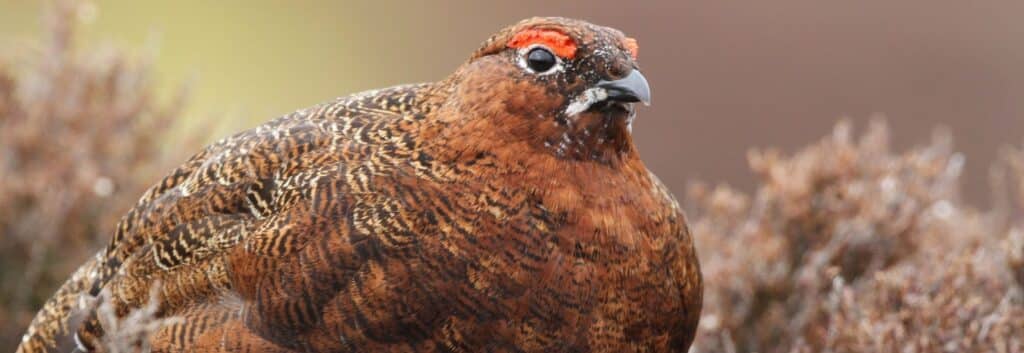Facts about Red Grouse
Scientific name: Lagopus scotica
Bird Family: Grouse
UK conservation status: Green
At a glance
- Endemic UK resident, living and breeding in the often harsh conditions of upland moorlands of Great Britain and Ireland
- Wild at all times, numbers are nevertheless maintained at artificially high levels by gamekeepers.
- Up to half a million are shot between August 12th (the ‘Inglorious’ 12th) and December.

A Red Grouse was chosen as the logo for British Birds magazine in 1907 because it was thought to be a species unique to the UK. That foresighted decision was proved correct in 2024 when genomic evidence and differences in plumage saw Lagopus scotica split from continental Europe’s Willow Ptarmigan, making Red Grouse and Scottish Crossbill our only two endemic bird species.
Red Grouse are beautifully adapted birds, living and breeding in the often harsh conditions of upland moorlands of Great Britain and Ireland. Densely feathered (with feathered legs to protect them from the cold), they have short, strong beaks designed for eating shoots, seeds and flowers of heather, but may also take some berries such as bilberry and other moorland plants. Reddish-brown all year round, their ‘Goback, Goback, Goback’ call will be familiar to anyone who has spent time walking in hilly areas like the Peak District or Cairngorms.
They are also of course familiar because of shooting.
The Red Grouse has been walked-up (ie flushed, usually using dogs) and shot since Stuart times, but driven shooting didn’t become fashionable amongst the aristocracy and wealthy landowners until the invention of the breech-loaded gun. Self-styled ‘intrepid sportsmen’ began to undertake shooting expeditions to the English, Welsh and Scottish moors, travelling by carriage or on horseback over the new turnpike roads and staying at inns or farmhouses.
Estate records indicate that driven grouse shooting started in earnest on the Duke of Rutland’s moors at Longshaw in Derbyshire in 1849, and was being carried out on a regular basis on the Duke of Devonshire’s moors at Bolton Abbey in Yorkshire by the late 1850s. Popularised by the royal family who still take annual holidays to their private grouse moor at Balmoral, grouse shooting as we know it now (using beaters, butts, and killing for ‘fun’ rather than for food) is organised on an industrial scale and Red Grouse are shot in huge numbers every year.

Unlike pheasants and partridges, Red Grouse are not ‘reared and released’ by the grouse industry – they remain wild birds at all times – but they are treated much like farmed animals: tallied up as ‘units’, fed medication to stop the diseases of stress and over-crowding, and sold off to ‘consumers’ when they’re a few months old.
Shooting starts in August on what is now widely derided as the ‘Inglorious 12th’ (a phrase popularised by Dr Mark Avery’s thorough examination of driven grouse shooting in his 2015 book ‘Inglorious: Conflict in the Uplands’) and ends in December. The destruction of habitat and native predators and the well-known illegal persecution of birds of prey to prepare for the killing takes place all year round though.
Twelve months of killing and destruction so that a few shooters can enjoy a day of ‘fun’ in some of the most biologically-important landscapes in the UK. How does that marry up with attempts to restore landscapes and live alongside our wildlife rather than simply exploit them?
It’s well past time shooters stopped killing Red Grouse and other moorland species.
Despite the damage caused by grouse shooting, Red Grouse – one of just two bird species endemic to Great Britain – receive virtually no protection at all from conservation organisations which argue that they don’t have the resources to protect all species and can only focus on ones of conservation concern.
What additional resources would it take to allow Red Grouse – social, sentient animals, perfectly evolved for living in damp, often cold conditions – to breed in relative peace on the moors they’ve bred on for thousands of years though? Ignoring the shooting of up to half a million birds because they’re ‘not rare enough’ is not a position Protect the Wild will ever support.

READ OUR RECENT SUBSTACK POSTS ON RED GROUSE AND GROUSE SHOOTING
Are Red Grouse wildlife? The RSPB seems to leave the question open (July 2025)
Ban Grouse Shooting Debate – Like the General Election never took place (July 2025)
Moscar Moor: a blight on the Peak District (June 2025)
Government fails Nature again, rejecting call for grouse shooting ban (January 2025)
Grouse Moor Licencing: the legal mess we always thought it would be (November 2024)
